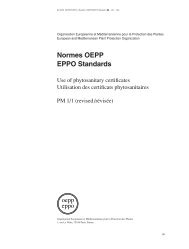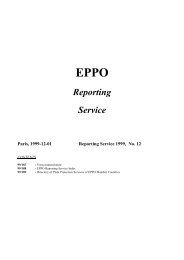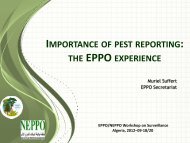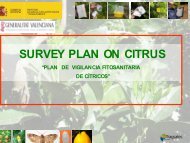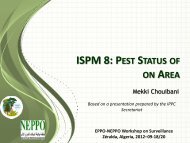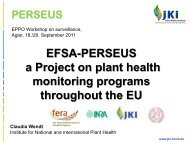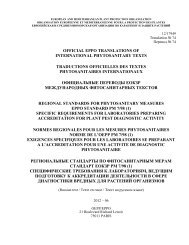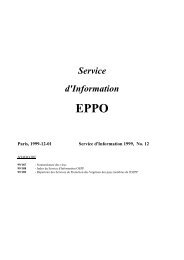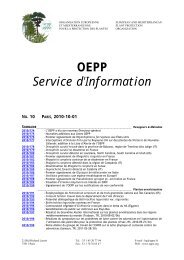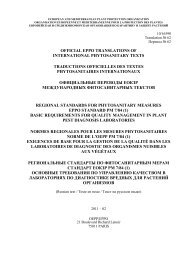EPPO Reporting Service - Lists of EPPO Standards - European and ...
EPPO Reporting Service - Lists of EPPO Standards - European and ...
EPPO Reporting Service - Lists of EPPO Standards - European and ...
You also want an ePaper? Increase the reach of your titles
YUMPU automatically turns print PDFs into web optimized ePapers that Google loves.
<strong>EPPO</strong> <strong>Reporting</strong> <strong>Service</strong> – Pests & Diseases<br />
Tescari G (2004) [First record <strong>of</strong> Leptoglossus occidentalis (Heteroptera: Coreidae) in<br />
Croatia.] Entomologia Croatica 8(1/2), 73-75 (abst.).<br />
Tomiczek C, Cech TL, Furst A, Hoyer-Tomiczek U, Krehan H, Perny B, Steyrer G (2008) [Forest<br />
protection situation 2007 in Austria]. Forstschutz Aktuell no. 42, 3-7 (in German).<br />
Vázquez MA, Costas M, Outerelo R, Melero-Alcíbar R (2009) [An invasive true bug in the<br />
Community <strong>of</strong> Madrid: Leptoglossus occidentalis Heidemann, 1910 (Hemiptera:<br />
Heteroptera: Coreidae)]. Heteropterus Revista de Entomología 9(1), 49-51 (in Spanish).<br />
Werner DJ (2006) [Leptoglossus occidentalis new in Germany]. Heteropteron no. 23, p 38 (in<br />
German).<br />
Wyniger D (2007) First record <strong>of</strong> Leptoglossus occidentalis (Heteroptera, Coreidae) in<br />
northern Switzerl<strong>and</strong>, with additional records from southern Switzerl<strong>and</strong>. Mitteilungen der<br />
Schweizerischen Entomologischen Gesellschaft 80(3/4), 161-165 (abst.).<br />
INTERNET (last retrieved in 2010-01)<br />
Delattinia website (fauna <strong>and</strong> flora <strong>of</strong> Saarl<strong>and</strong>, Germany). Wanzen. Aktuelle Neufunde.<br />
http://www.delattinia.de/Sektion_Wanzen.htm<br />
Additional key words: new record, detailed record Computer codes: LEPLOC, AT, BE, BG, CA, CH, CZ, DE, ES, FR,<br />
GB, HR, HU, IT, JP, ME, MX, PL, RS, SI, SK, US<br />
2010/010 Oxycarenus lavaterae found for the first time in the Netherl<strong>and</strong>s<br />
The NPPO <strong>of</strong> the Netherl<strong>and</strong>s informed the <strong>EPPO</strong> Secretariat <strong>of</strong> the first record <strong>of</strong><br />
Oxycarenus lavaterae (Heteroptera: Lygaeidae) on its territory. Aggregates <strong>of</strong><br />
overwintering bugs were found in 2007 in a nursery on Tilia cordata plants which had been<br />
imported from Italy. Because O. lavaterae already occurs in Europe with a low economic<br />
impact <strong>and</strong> has the potential to spread naturally, no phytosanitary measures were taken in<br />
the Netherl<strong>and</strong>s.<br />
The pest status <strong>of</strong> Oxycarenus lavaterae in the Netherl<strong>and</strong>s is <strong>of</strong>ficially declared as:<br />
Present, at low prevalence.<br />
O. lavaterae feed <strong>and</strong> develop on plants belonging to the Malvaceae family, such as<br />
Althea, Hibiscus, Lavatera, <strong>and</strong> Malva sylvestris but do not cause particular damage. It is<br />
considered that 2 generations usually take place on these hosts during the vegetation<br />
period. Large adult colonies overwinter on trees, mainly on lime trees (Tilia americana, T.<br />
cordata, T. parviflora, T. platyphyllos), <strong>and</strong> less frequently on other species (Populus,<br />
Platanus, Aesculus hippocastanum). Adults do not cause plant damage but may be a<br />
nuisance in urban environments because <strong>of</strong> the high numbers <strong>of</strong> individuals.<br />
Pictures <strong>of</strong> the insect can be viewed on the Internet:<br />
http://www.galerie-insecte.org/galerie/ref-1260.htm<br />
http://commons.wikimedia.org/wiki/Category:Oxycarenus_lavaterae<br />
Until recently, O. lavaterae was considered to occur only around the Mediterranean Basin<br />
<strong>and</strong> in Africa, but it is now spreading towards Northern <strong>and</strong> Central Europe. It is not known<br />
whether this is a consequence <strong>of</strong> global warming or an adaptation <strong>of</strong> the species to colder<br />
conditions than in its area <strong>of</strong> origin. The <strong>EPPO</strong> Secretariat has gathered the following<br />
tentative distribution list:<br />
<strong>EPPO</strong> region: Austria (first found in 2001, now in Burgenl<strong>and</strong>, Steiermark, Niederösterreich<br />
<strong>and</strong> Vienna), Bosnia <strong>and</strong> Herzegovina, Bulgaria (1998), Croatia, Czech Republic (2004),<br />
France (south, but spreading towards the north since the 1970s), Germany (2004),<br />
Hungary, Italy, Montenegro, Portugal, Serbia, Slovakia (1999), Slovenia, Spain, Switzerl<strong>and</strong><br />
(in the South but first found in 2004/2005 in Basel).<br />
Africa: O. lavaterae is considered to be an Afrotropical insect but no specific data could<br />
be found on its distribution in Africa.<br />
12




